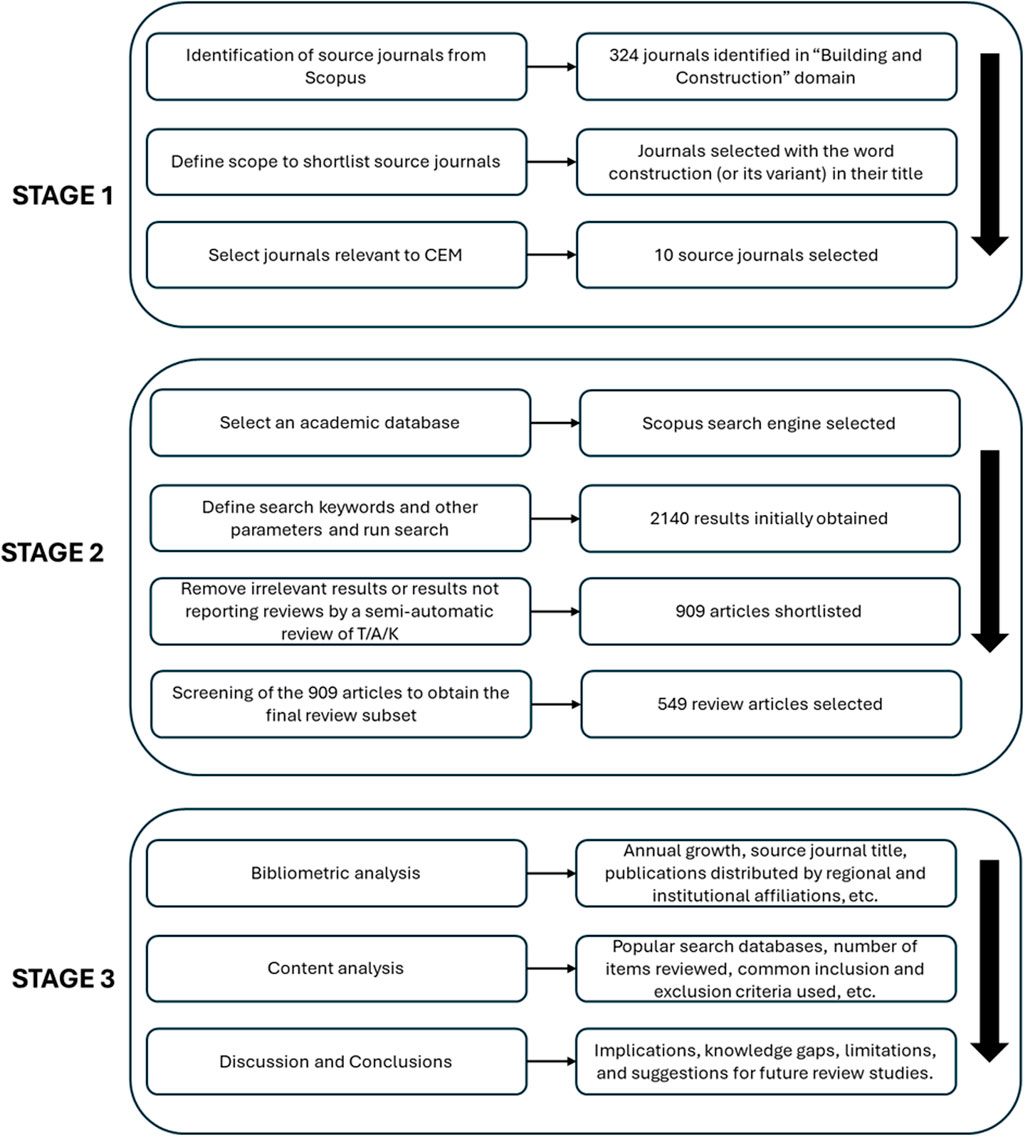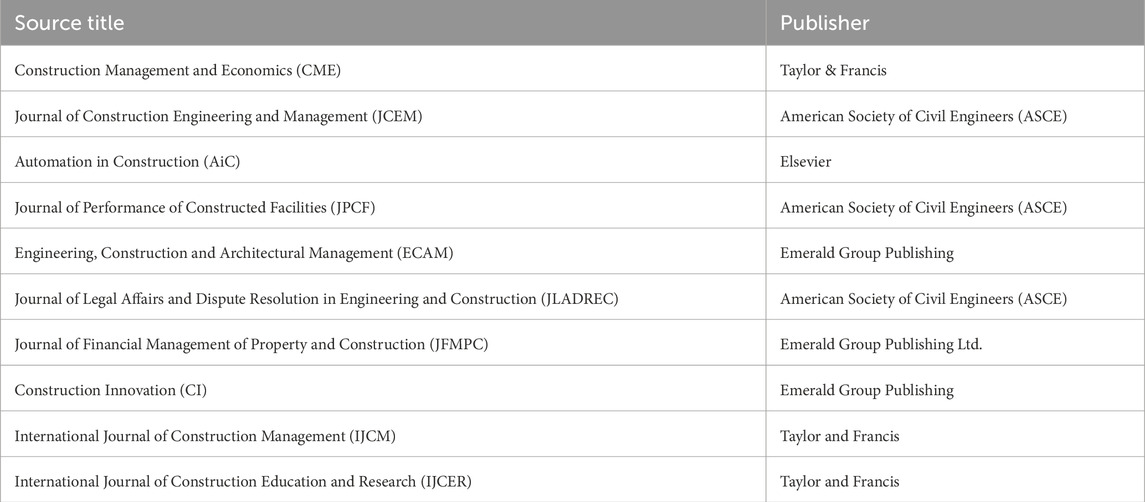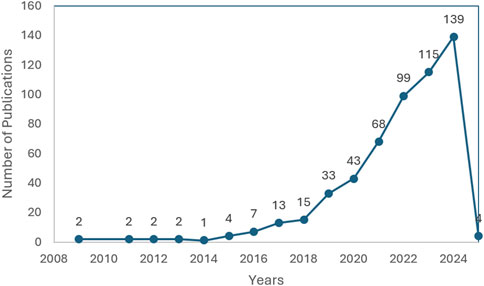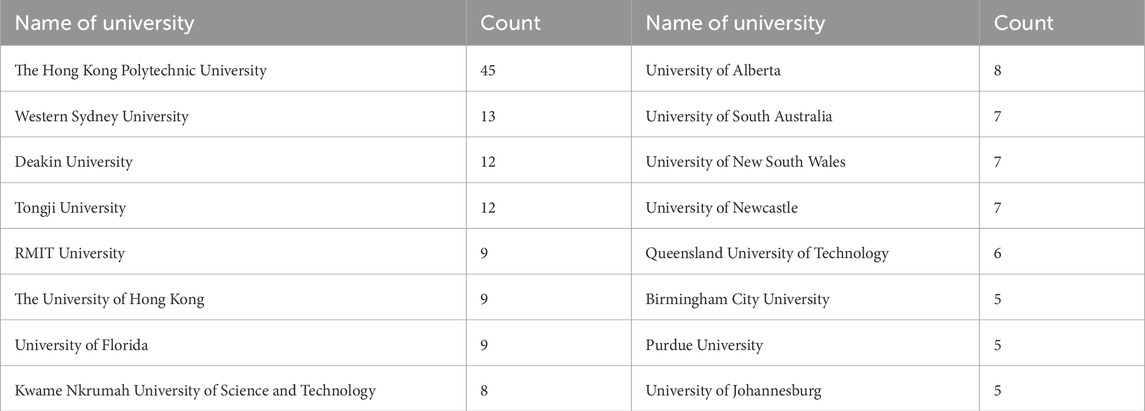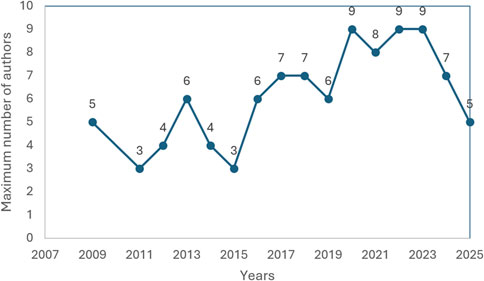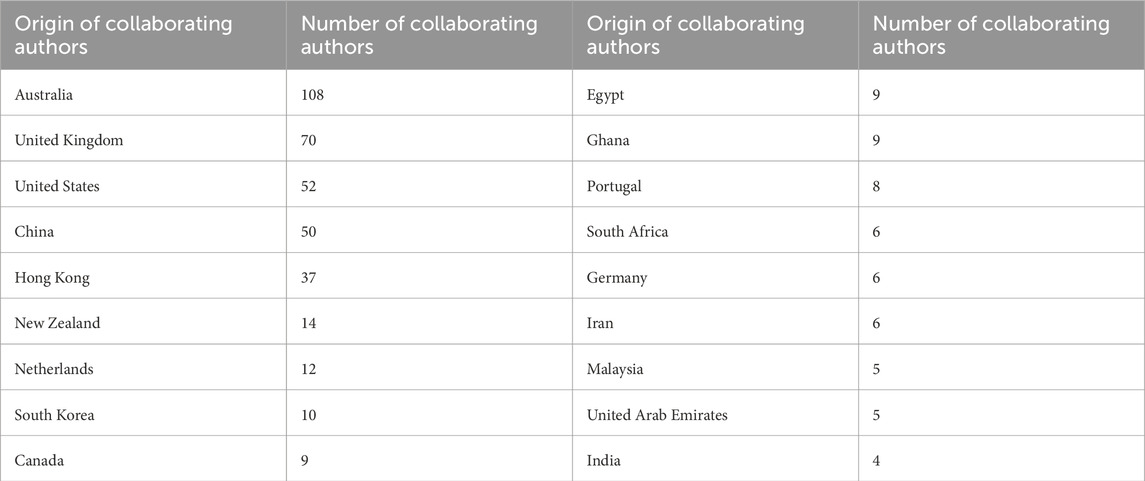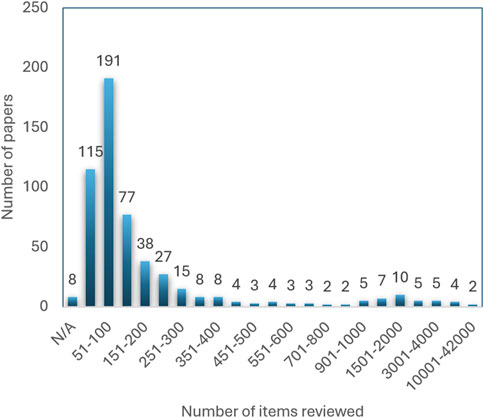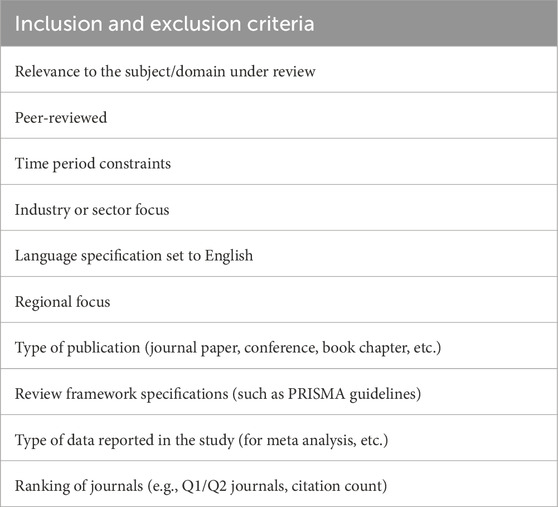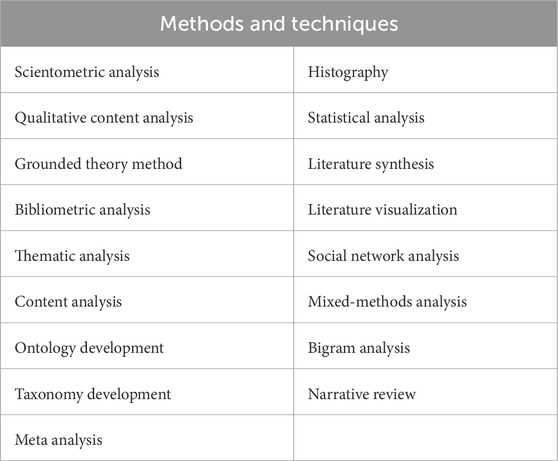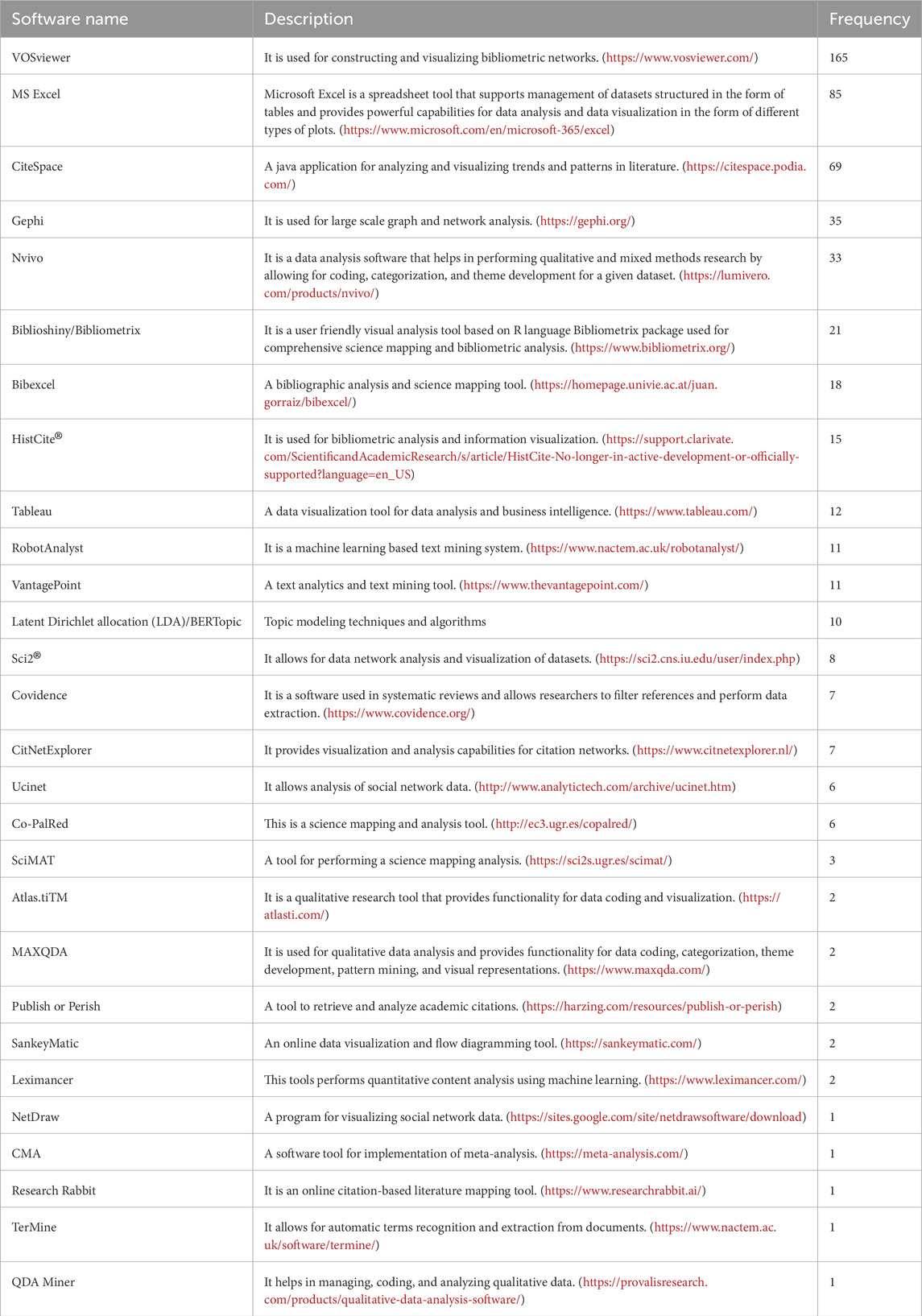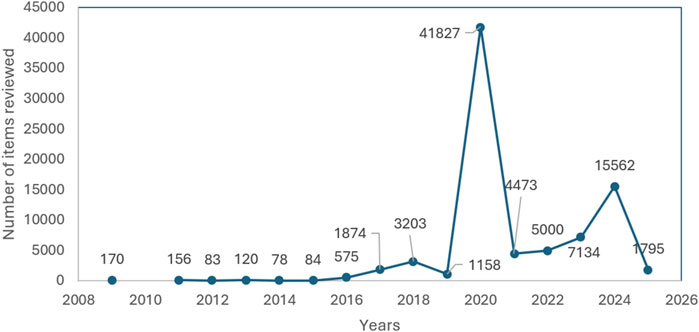- 1Department of Architectural Engineering and Construction Management, King Fahd University of Petroleum and Minerals, Dhahran, Saudi Arabia
- 2Interdisciplinary Research Center for Construction and Building Materials, King Fahd University of Petroleum and Minerals, Dhahran, Saudi Arabia
Review studies are critical in all knowledge domains to benchmark the state-of-the-art at a given point in time and to identify possible future research directions. Due to the fragmented and ever evolving nature of the construction industry, research in the field of construction engineering and management (CEM) is growing exponentially. Researchers across the world are publishing reviews in CEM and the body of knowledge of reviews in this field has become large and significant. While considering literature reviews in CEM as a separate class of CEM research, there has been no attempt to date to analyze and document publication trends and to summarize methods and approaches being utilized in drafting these reviews. Moreover, there is no documented reference that tracks or highlights the concentration or scarcity of literature reviews in various domains and sub-domains of CEM research. Following the PRISMA protocol, this systematic literature review (SLR) aims to benchmark the existing reviews in the field of CEM and to chart the growth of interest of researchers in publishing reviews. A total of 549 review studies were obtained from the Scopus database, as of 20 December 2024, based on relevance, accessibility, and other inclusion and exclusion criteria adopted for this review. Bibliometric analysis shows an exponential annual growth in review studies with Australia, China, US, Hong Kong, and the UK leading this growth. According to the metrics, the journal of Automation in Construction has published the largest number of reviews in the field of CEM. Reviews focusing on applications of robots, automation, and digital technologies in construction constitute about 52% of the reviews published in CEM. Part of this review employed various models of ChatGPT for data extraction from shortlisted articles, therefore risk of bias was minimized by using the tool for simple tasks only. This review is one of its kind and the analysis and findings presented herein are expected to assist researchers in conducting more focused reviews in CEM in the future.
Introduction
The production of literature in the field of CEM is accelerating at a fast pace and this is evidenced by many published review studies in this field. For example, a review study on off-site construction supply chain challenges shows that the number of relevant articles published from 2018 to 2022 tripled the number of articles published from 2012 to 2017 (Li et al., 2024). Similarly, another recent review on the use of immersive virtual reality technology in construction management student learning shows a 3.5 times increase in articles published in the years 2019–2023 as compared to the time period between 2014 and 2018 (Ohueri et al., 2025). These are just two examples among many that strengthen the argument that literature in CEM is growing fast. Another dimension to this challenge of exploding knowledge is the diversity in subjects, domains, and sub-domains being researched under the broad field of CEM. This diversity is primarily because of the fragmented structure of the construction industry itself, which is composed of a large number of unique stakeholders and work processes that retard collaboration (Alashwal and Fong, 2015; Nawi et al., 2014; Riazi et al., 2020). Progressive and incremental industrial revolutions, the consequent introduction of disruptive technologies, and sustainability concerns are other very influential forces changing the entire landscape of how the construction industry and its stakeholders interact and operate (Lekan et al., 2021; Setaki and van Timmeren, 2022). The fragmentation of the construction industry and the powerful external influences mentioned earlier drive research in the field of CEM, thus bringing extreme variety and breadth to it. Thus, research in CEM focuses on implementation of digital technologies in design and construction, automation, circular constriction, lean project delivery, resource optimization, project management, claims, disputes, and many other domains and sub-domains of significance. Therefore, in order to keep up with the state-of-the-art in each domain and sub-domain, researchers across the world have taken the responsibility to collect, assess, and summarize this growing knowledge and to publish it in the form of literature reviews that are drafted based on a variety of review types and methodologies. All of these reviews share common objectives which include highlighting trends in research, highlighting important themes, uncovering knowledge gaps, developing theoretical frameworks and conceptual models, and benchmarking the status quo at the level of an industry or technology sector, among others. But this approach looks inward while focusing on various domains and subdomain in CEM research. There is no evidence at the level of body of knowledge of CEM reviews themselves to determine which domains and subdomains in CEM have been adequately reviewed.
Grant and Booth (2009) described 14 different types of reviews and their associated methodologies (critical review, literature review, systematic review, mapping review, meta-analysis, mixed-methods review, overview, scoping review, etc.) and provided illustrative examples from the health and health information domains. The authors argued that a limited number of review types were utilized in the health information domain. The same argument may also apply to review-based research in the field of CEM, however, this needs to be backed up by evidence. Other questions that arise with the growth of knowledge and the leading review studies include: what subjects, domains, and sub-domains have already been reviewed? what subjects, domains, and sub-domains still need to be reviewed? what types of reviews are more prevalent and effective in benchmarking existing knowledge in various subjects, domains, and sub-domains? and what is the general level of quality and rigor of these reviews? While each of these questions warrants an independent research effort and that too at a magnanimous scale, considering the scale of reviews already published in the CEM field, this research sets out to answer a more fundamental question, i.e., what are the characteristics of reviews conducted in the field of CEM to date? This question needs an answer to comprehend the nature, status, and attributes of the breadth of reviews already published in the field of CEM. Review of literature reviews are quite common in the field of medicine, e.g., Ekeland et al. (2010) conducted a systematic review of reviews to establish the effectiveness of telemedicine. Similarly, O’Brien et al. (2024) executed an umbrella review of systematic reviews and meta-analyses to study the effects of sedentary time/behaviors on blood pressure and cardiovascular disease. Another example of systematic review of reviews includes a study by Khosravi et al. (2024), where the authors adopted a qualitative method to review existing reviews to determine the scope of applications of AI tools in the decision-making process in healthcare service delivery networks. Outside of the field of medicine, Raman et al. (2024) investigated a decade worth of AI review research to reveal insights into its evolution and impact. Yet another example of such studies includes the systematic review of literature reviews undertaken by Shehata et al. (2024) while targeting reviews focusing on student-centered learning and the role of educational technology in supporting it. According to Raman et al. (2024), “The concept of a ‘review of reviews’ or meta-review has been effectively employed in other disciplines to consolidate findings, identify research gaps, and propose new directions.”
A “systematic review” is described by Grant and Booth (2009) as the best-known type of review where the review exercise seeks to systematically search for, appraise and synthesize research evidence by often adhering to prescribed guidelines. The transparent reporting of the review process and the methods facilitates others to replicate the process. According to Pati and Lorusso (2018), a SLR “… is a research methodology to collect, identify, and critically analyze the available research studies …” following a systematic procedure to methodically organize the review. It updates a reader of the review about the current state of the literature on a subject. Thus, one of the objectives of the SLR reported in this research is to evaluate the reviews published in CEM research and to highlight general attributes and trends based on a bibliometric analysis, including: annual rate of review publications, top journals, top contributing countries and institutions, citation analysis, and other attributes. This review also intends to highlight high-level themes or categories of reviews published in CEM, types of reviews conducted, research databases used and their frequency, common inclusion and exclusion criteria used to shortlist relevant literature, and other article level structural details of importance. While considering literature reviews in CEM as a separate class of CEM research, there has been no attempt to date to analyze and document publication trends and to summarize methods and approaches being utilized in drafting these reviews. Moreover, there is no documented benchmark that tracks or highlights the concentration or scarcity of literature reviews in various domains of CEM. This research provides one of the first benchmarking study of reviews in the field of CEM. It intends to set the base for and to spark interest in executing more focused reviews in the field of CEM in the future.
Conducting a literature review is a laborious task and based on the volume of the data to be reviewed, it could be an exceptionally large exercise. This research exploits the benefits provided by large language models (LLM) to assist in and to partially automate data extraction from reviewed papers. A LLM is a language model that is trained to understand and process human language (Yao et al., 2024). There are a number of LLMs that now exist with Open AI’s ChatGPT being a notable example. These models, among other features, provide the ability to summarize text. Hence, various models of ChatGPT were utilized in this review to extract information from the full texts of shortlisted CEM review papers.
Methodology
This review employed a SLR methodology to evaluate the characteristics of review studies published in the field of CEM. The Grounded Theory method (Wolfswinkel et al., 2013) was applied in this review to conduct the SLR in five stages which include establishing the criteria for search, conducting the search for relevant articles, shortlisting the articles to obtain a refined sample, analyzing the shortlisted articles, and then finally presenting the results. This methodology for reviewing has been popularly used in reviews in CEM research (Celoza, 2024). Additionally, to ensure a high-quality review and its proper documentation, the PRISMA 2020 checklist was employed. The review exercise was broadly divided into three stages. Stage 1 entailed defining the source journals for extracting CEM review studies, stage 2 included the search, retrieval and shortlisting of relevant review papers for the review exercise, and stage 3 resulted in analysis, discussion, and conclusions, as shown in Figure 1.
The Scopus search engine was utilized to extract relevant papers for this review and the search exercise was conducted on 20 December 2024. Use of a single academic database may introduce the risk of omissions of studies that may have not been indexed yet or that may be available in other databases. This choice of academic database was made on the popularity of its use in many review studies published in the domain of CEM (Bakhshi et al., 2024; Ohueri et al., 2025; Zhang et al., 2024). Furthermore, it affords the ease of handling only one dataset whereas using multiple databases introduces an additional step in data management where duplicate records have to be considered and removed. Initially, the target was to identify all sources (journals) that focus on publication in the domain of construction. According to Scopus’s sources list, there are 324 journals that publish in the domain of “Building and Construction.” Due to the multidisciplinary nature of many research journals, it was decided that only those journals will be considered that have the word construction or its variants such as constructing, constructed, etc., in their title. This was necessary to reduce the scope of the review otherwise, for example, many journals including Journal of Cleaner Production, Journal of Management in Engineering, International Journal of Project Management, also publish research in the field of CEM. Some journals focusing on materials and structural design in construction were also removed. These included: Construction and Building Materials, Journal of Constructional Steel Research, Journal of Composites for Construction, Materials and Structures/Materiaux et Constructions, Practice Periodical on Structural Design and Construction, and Steel Construction. In total, 10 sources were identified for conducting this review study (Table 1).
Thereafter a search was initiated via Scopus search engine to retrieve all the published review articles while making sure that those reviews are conducted in construction projects and their management. The keywords used for conducting the search included “review,” “construct*,” “project*,” and “manag*.” The use of asterisk symbol within the search keywords ensures that all variants of that keyword are automatically considered. Such as for the keywords of construct, construction, constructing, and constructed, we can use only construct* instead. The search was limited to the subject area of engineering and the article language was set to English. The following search query was used as of 20-12-2024. The full search string used for querying the Scopus database is given below:
TITLE-ABS-KEY (“review” AND “construct*”) OR TITLE-ABS-KEY (“review” AND “project*”) OR TITLE-ABS-KEY (“review” AND “manag*”) AND (LIMIT-TO (SUBJAREA, “ENGI”)) AND (LIMIT-TO (LANGUAGE, “English”)) AND ((LIMIT-TO (EXACTSRCTITLE, “Journal Of Construction Engineering And Management”)) OR (LIMIT-TO (EXACTSRCTITLE, “International Journal Of Construction Management”)) OR (LIMIT-TO (EXACTSRCTITLE, “Construction Management And Economics”)) OR (LIMIT-TO (EXACTSRCTITLE, “Construction Innovation”)) OR (LIMIT-TO (EXACTSRCTITLE, “Journal Of Legal Affairs And Dispute Resolution In Engineering And Construction”)) OR (LIMIT-TO (EXACTSRCTITLE, “Automation In Construction”)) OR (LIMIT-TO (EXACTSRCTITLE, “Engineering Construction And Architectural Management”)) OR (LIMIT-TO (EXACTSRCTITLE, “Journal Of Financial Management of Property and Construction”)) OR (LIMIT-TO (EXACTSRCTITLE, “International Journal Of Construction Education And Research”)) OR (LIMIT-TO (EXACTSRCTITLE, “Journal of Performance of Constructed Facilities”)))
Based on the initial search, 2,140 results were displayed showing articles where potential reviews might have been reported. The Scopus search engine allows to apply filters where the type of article can be set to “review,” but it was observed that this may lead to missed articles, therefore screening was preferred over automatic filtering. No search results matching the search criteria were reported by Scopus for the JFMPC and JPCF journals. Two inclusion criteria were established to identify relevant review studies, i.e., i) articles reporting pure academic literature reviews in the field of CEM, and ii) articles with access to download full text. The records were manually reviewed by the author at the level of title of the studies and those that mentioned the keywords “review,” “bibliometric,” and “scientometric,” suggesting a review study, were taken into account for further analysis (620 articles). The remaining 1,520 studies were subject to a semi-automatic review where ChatGPT 4 Turbo model was utilized to quickly review abstracts and identify those studies where any form of data collection (surveys, questionnaires, interviews, case studies, focus groups, workshops, expert consultations) was reported in addition to a review (Gu and Guo, 2024; Hansen, 2024; Likita et al., 2024). Also, those studies that developed any frameworks and models based on a review were also identified. ChatGPT generated summaries against the prompt (instructions/questions) provided were then manually reviewed. Several attempts were made to redesign a prompt that can identify studies with any primary data collected or any models/frameworks developed. It was found that unless a detailed prompt mentioning all possible keywords representing a data collection effort are mentioned, ChatGPT is unable to read the abstracts and determine if any primary data was collected. It will then erroneously report that no primary data was collected. Therefore, the ChatGPT was instead employed to simply report if any data was collected and then a manual review of the abstract performed to determine if the review study qualified to be included. All such results (978) were immediately removed from further consideration. It was determined that many different types of reviews were performed by researchers including literature reviews, reviews for proposition and development of theoretical frameworks, reviews to establish theoretical background on selected topics, case law reviews, reviews of legal frameworks, institutional policies, and regulations. The remaining 542 abstracts had to be manually reviewed as ChatGPT could not provide any specific help. Another 254 papers were removed as they were deemed unsuitable for the reasons mentioned above leaving 289 papers that were included with the initially shortlisted 620 articles for a detailed review thereby making the total papers to be reviewed to 909 articles.
Later, screening of the full-text of 909 shortlisted articles was performed (where available) which included querying the LLM again. For this purpose, the ChatGPT 4o mini model was utilized because full text screening can cost a lot with other more advanced and expensive models. A custom Python script was utilized to bring the full text of all the articles in a MS Excel workbook where an API (ChatGPT for Excel) was utilized to query the LLM to review all the text from the papers. 48 papers could not be retrieved due to access issues. The results to various prompts showed that some published reviews included significant amount of non-academic materials (e.g., websites, legal cases, court judgements, newspapers, industrial reports, etc.) (Al-Bayati et al., 2021; Lopez et al., 2016; Meikle, 2001), resulting in exclusion of such papers form this review exercise. Similarly, in some published literature reviews a clear academic database (e.g., Scopus, web of science, etc.) was not specified which was utilized by the authors to search for and retrieve papers for the reported reviews (Arif and Egbu, 2010; Aziz et al., 2006; Bakis et al., 2007). Such published reviews were also excluded from this review exercise. Finally, after removal of review articles that did not meet the inclusion criteria, a total of 549 journal articles remained that were reviewed to extract relevant data. The following data was collected for the review analysis: source journal title, year of publication, names of authors, affiliation details of authors (universities/institutes, countries), number of citations until the date of retrieving the data from Scopus, academic databases employed in each review article, number of pieces of literature reviewed in each review study, types of sources (journal articles, conference papers, books, theses, patents, etc.) reviewed in each review study, review period in years, knowledge area/domain/theme of the review conducted, inclusion/exclusion criteria adopted, review/analysis methods and techniques employed, and any software and tools used to conduct the review. Some of this information was obtained from the Scopus downloadable dataset from the original search query while other information was obtained from a ChatGPT assisted querying of information and manual content analysis.
Overview of the reviews published in the field of CEM
The data extracted from the Scopus search engine was used to perform the following analysis.
Number of publications per year
The earliest review in CEM from the shortlisted papers was published in September 2009 by Ke et al. (2009). There were reviews identified in the initial search, published as early as early 1990s and then many more after that but all of these reviews were taken out of the final review sample due to the exclusion criteria mentioned earlier. As shown in Figure 2, the trend in publishing reviews shot up in the year 2017 when twice the number of reviews were published as compared to the previous year and then the trend shows an accelerated growth in publications with the year 2024 witnessing a total of 139 review publications in a single year, the highest number in the study period. The dataset contained four publications for the year 2025 but these can be ignored as this year is not considered within the review window. Only one review paper was published in the year 2014 whereas all other years in the review period saw at least two papers getting published. This shows a clear and unmistakable growth in interest of researchers globally, in writing reviews on various subjects in CEM.
Publication journal title
According to Table 2, the AiC leads all other journals with the highest number of reviews published. It is followed by ECAM, while all other selected journals have published less than 100 review articles. AiC also leads all other journals in the total citations count in a significant way. It accounts for 63.9% of the total citations gathered by all the journals included in this study whereas the next leading journal in terms of citations is ECAM which accounts for only 11.4% of the total citations. This huge gap in citations clearly shows how well the research community regards the quality of publications in AiC. Another possible explanation for the high number of citations gathered by the AiC may be that this journal focuses on various research themes under the Construction 4.0 and Digital Transformation domains, both of which are a major focus of researchers in construction around the world.
Publications distributed by regional and institutional affiliations
According to Table 3, Australia leads in producing review publications in the field of CEM. China, US, HK and the UK follow the lead with more than 50 reviews published from each country. It is interesting to see that one institution from Hong Kong, i.e., The Hong Kong Polytechnic University leads all other universities by a significantly large number of reviews in CEM, produced during the study period (Table 4).
Figure 3 shows trends in production of reviews in the field of CEM for a select few countries that have produced more than 25 reviews in the review period. Ignoring the year 2025 because this review covers papers only by the end of year 2024, it is clear that researchers from Australia and China are getting more serious about conducting literature reviews as their annual number of review publications in the field of CEM see a continuous growth. US, HK, UK and Malaysia also show a growing interest in publishing reviews albeit with dips in output in certain years.
Number of authors, co-authors, and their affiliations
Table 5 shows that a total of 24 review publications were authored by a single researcher whereas four publications had nine authors, the maximum number of authors in the reviewed papers. Figure 4 shows a general trend of increasing number of authors in a paper, over the years. Papers published after the year 2015 include more and more instances of four or more collaborating authors for a given paper. According to Jakab et al. (2024), author numbers per article have risen in recent decades in various journals and fields. One plausible reason for the growing number of authors with time may be linked to the growing scope of CEM review studies over time. Review studies spanning hundreds of articles would generally require a team effort to manage the scope and quality of the review exercise. Kuperman and Sokol (2024) studied the causes and ramifications of multi-authorship in science by surveying researchers in the field of medical physics. Division of labor and complementary expertise were stated as some of the important causes of this trend.
Table 6 shows the details of the countries of affiliations of the collaborating authors (other than the first author). Among the reviewed papers, researchers from Australia appeared in collaboration 108 times. This does not mean that 108 papers contained collaborators from Australia, rather it means that total instances of collaboration from Australia are 108, where in a given paper more than one researcher from Australia may have contributed.
Content analysis of reviews published in the field of CEM
ChatGPT 4o mini and Microsoft Excel were utilized as tools to extract and code information while performing content analysis of the selected 549 articles. Prompts had to be carefully designed and redesigned in an iterative manner to mine information from the review articles. ChatGPT 4o mini was the model of choice for content analysis as it is the cheapest in operation on a cost per token basis. It was observed that such a LLM can make frequent errors in reading through journal articles, by providing fabricated information if the relevant information related to a prompt is not clearly mentioned in an article. For example, if a prompt requires the LLM to review the text of a review article to determine the research database used for obtaining relevant review studies and suppose that the authors have not mentioned this explicitly, the output can be erroneous in this case where the LLM assumes a database name by itself. This requires prompt engineering to “ask the right question” with sufficient details and parameters. Eventually, the errors are reduced but the risk of fabricated information or erroneous outputs cannot be reduced to zero. Therefore, for the purpose of this section of the review, many iterations were conducted with revised prompts and the results were cross-checked with manual content analysis of randomly selected articles to check if errors still existed. Another limitation of LLMs is that they cannot be used to provide a count of instances since these are not by default counting algorithms and as such can make grave errors if still employed for this purpose. This is where Microsoft Excel proves to be a strong age old and reliable complementary tool. ChatGPT was employed to provide outputs to various prompts posed and the detailed analysis of the extracted data was performed on Microsoft Excel. Manual content analysis of review articles was employed randomly to ensure that the output obtained was indeed a fact and not a fabrication. However, not all the 549 review articles were manually reviewed in detail as this would defeat the purpose of integration of LLM for assistance in this research that reviews a large number of studies. Wherever, it was determined that a reliable quantitative count for the purpose of establishing a rank order would not be possible, simple listing of information items was employed to avoid making mistakes. This can be seen, e.g., in the data presented in Table 9 (below).
It is customary in literature reviews to first identify search engines that will be utilized to mine the review materials such as journal papers, conference papers, etc. The actual list of databases used by researchers is longer therefore Table 7 shows popular databases which have been employed in at least 15 papers out of the 549 reviewed papers. The Scopus database was the most frequently used research database in the CEM reviews. Web of Science (WoS) is the second most frequently used database. 331 papers reviewed used more than one database for search and retrieval of relevant materials whereas the rest of the papers (218) used only one database. 143 review papers used Scopus database only whereas 64 used only WoS. For example, Bakhshi et al. (2024) used only Scopus database in their review study whereas Li et al. (2024) employed WoS database for their review research. Charles et al. (2022) used six databases including Scopus, ScienceDirect, ProQuest, Web of Science, Engineering Village and Google Scholar. Tong et al. (2023) used 13 databases, the largest number of databases used in a single review, including Google Scholar, Web of Science, PubMed Central, Scopus, Cumulative Index of Nursing, Allied Health Literature, Engineering Village, PsycINFO, PsycARTICLES, PsycBOOKS, PsycEXTRA, PsycCRITIQUES and China National Knowledge Infrastructure. Scopus, WoS, and other similar databases index journals from several publishers, therefore they provide ease of access to vast research information. Some researchers employed a single journal database such as in Pietroforte and Stefani (2004) and Jin et al. (2019), who reviewed database of the JCEM only in their review studies.
It is also apparent that researchers use a wide variety of items to draft their literature reviews including journal papers, conference proceedings, books, grey literature, reports, theses, book chapters, patents, standards, newsletters, newspapers, magazines, international treaties, legal articles, models, and procedures. For example, Celoza (2024) employed only journal articles in the author’s review, which is a very common strategy in CEM reviews. However, Wang et al. (2024) used both journal articles and conference papers in their review. Ohueri et al. (2024) in their review study employed articles, reviews, and book chapters, whereas Bedarf et al. (2021) analyzed publications from conferences, peer-reviewed journals, book chapters, patents, and web pages. Figure 5 shows the distribution of the number of items reviewed in the shortlisted review articles. According to Figure 5, the most common total number of items reviewed are in the range of 51–100 and 191 reviewed articles concur with this range. About eight reviewed articles did not clearly mention the total number of items reviewed.
Table 8 shows review studies that covered the largest and the smallest number of items in a review. A review of Table 8 shows that the smallest number of studies used in a review is 5 (Akunyumu et al., 2021). Another example of a review paper that used a small number of items (10 papers) for review includes the work by Cotella (2023). The largest number of studies included in one review were 41,827 publications covered in a scientometric analysis conducted by Darko et al. (2020). Other examples of reviews with the highest number of articles reviewed include Dou et al. (2023) with 7,134 articles and Cassandro et al. (2024) with 15,562 articles. Depending upon the objectives of the review and the size of the dataset to be analyzed, researchers use different review methodologies. For example, Darko et al. (2020) employed the science mapping method to analyze the literature and for visualizing significant patterns and trends in a large body of literature and bibliographic data. On the other hand, Cassandro et al. (2024) used the Latent Dirichlet allocation (LDA) method to perform thematic analysis to objectively and systematically process large volumes of textual data. LDA is a probabilistic model which captures implicit topic structure from a collection of documents (Kulkarni and Rodd, 2020).
Table 9 shows the common practices adopted by authors in these reviews to define grounds for relevance of inclusion of certain texts and relevance of exclusion of certain texts, to arrive at the final shortlisted items for a review study. These criteria serve as the backbone for any review study as these criteria help in shortlisting the most relevant studies in a particular review context.
The largest explicitly defined review period recorded was 74 years (from 1945–2019) in a paper by Nwajei (2021), whereas the smallest review duration explicitly reported in a publication was from 2020 to 2022, where Ghansah and Lu (2023) is a typical example. Many review studies did not provide an explicit review duration, a recent example being the review by Kang et al. (2024). This may also be due to the fact that some authors define the year up to which data search and retrieval was conducted, which implicitly means that all the previous years from the first relevant study are included by default.
Table 10 shows the set of review methodologies and analysis methods and techniques adopted by researchers in CEM review research, however these may not be exhaustive because it is hard to say if employing an LLM can provide exhaustive output for such a prompt. The only way to confirm this would be to manually review all the sampled articles. Rather than quantifying how many times each methodology was employed in the review dataset, only a listing is provided due to the limitations of the LLM mentioned earlier. However, a high-level analysis revealed that the top five individual review methods and data analysis techniques used across the reviews may be content analysis, thematic analysis, bibliometric analysis, statistical analysis, and scientometric analysis. Many review studies use mixed-methods where, e.g., both scientometric and content analyses or bibliometric and scientometric analyses are employed for the review exercise.
A scan of the selected articles showed use of several software tools by researchers for conducting various types of literature reviews. It is not necessary to use any application for a review, however, when dealing with large datasets or when complex plotting and visualization capabilities are required, then it becomes mandatory to use a software tool relevant for the defined purpose. These tools are especially helpful when performing bibliometric and scientometric analyses, such as VOSviewer, Citespace, and Gephi. For content analysis, Nvivo has a strong credibility in the research community. Table 11 shows the list of software tools mentioned and the frequency with which their mention appeared across the reviewed articles. MS Excel is used in almost all research projects to structure and manage data. There is a possibility that many researchers do not mention it explicitly, thus owing to the low frequency associated with it.
A careful manual analysis of the reviewed papers assisted in categorization of the reviews in defined domains (Figure 6). The assignment of the review articles to these categories was also performed based on a manual review of article titles, abstracts and keywords, since automation of this task using an LLM proved to be more difficult from an accuracy standpoint. The single largest domain receiving attention of researchers in the review of CEM research includes the cyber-physical systems (CPS) where 45 review articles can be further subdivided and allocated to the Robotics and Machines sub-domain in construction application research. 244 review articles can be assigned to the CPS domain under the digital technologies subdomain. Example reviews in the former sub-domain include reviews on automation in AEC industry (Klarin and Xiao, 2024), additive manufacturing materials (Carcassi and Ben-Alon, 2024), and human-robot collaboration for building deconstruction (Ohueri et al., 2024). Examples of the latter sub-domain include reviews on application of digital twin in construction supply chain (Bakhshi et al., 2024), analysis of BIM adoption (Chowdhury et al., 2024), and augmented reality in US construction (Toyin et al., 2025). The second and third categories that received the most attention in reviews are the construction health and safety and construction method categories. Typical examples of reviews in this category include application of wearable sensing technologies for monitoring status and behavior of construction workers (Wang et al., 2024), innovation in safety management for construction sites (Mohy et al., 2024), review on trenchless construction technologies (Lu et al., 2020), crane operations and planning in modular integrated construction (Hussein and Zayed, 2021), and fabrication methods of shell structures (Vatandoost et al., 2024).
Discussion
This review of reviews in the field of CEM in construction journals has provided interesting and one of the first insights in this growing and important type of research. The exponential growth of research in all domains and sub-domains of CEM over time is necessitating more and frequent review studies to benchmark the state-of-the-art. According to Figure 5, 43.4% of the reviewed articles have analyzed more than 100 items of literature. This is a significant portion of the reviewed sample showing how the need to review a large subset of literature is becoming increasingly important, thus indicating the growing scope and increasing level of difficulty of drafting these reviews. Excluding the outliers (41,827 items in a review in 2020 and 15,562 items in a review in the year 2024), the assertion made above is validated in Figure 7 which shows annual growth in the maximum number of papers reviewed in a publication in a given year. It is clear that after 2016, the number of items reviewed in large reviews easily crossed 1,500 items and after the year 2019, the number of items reviewed in large review studies has crossed 4,000 items. It can be expected that the scope of future reviews is going to increase and innovative methods to support review of such huge amounts of literature will be required to conduct quality reviews. For example, the two largest sample sizes to have been subject to content analysis/systematic review include 753 articles in a review study by Liang and Shi (2022) and 7,134 articles by Dou et al. (2023). Performing an insightful and meaningful review via content analysis, meta-analysis or other techniques that require in depth review is time consuming as they require careful reading and coding of the selected literature for the sake of a systematic review. Jeong et al. (2024) argued that reviewing papers is a time-intensive and laborious task that can be significantly accelerated by use of Large Language Models (LLM). The authors utilized LangChain integrated with an LLM (ChatGPT 3.5 Turbo) for literature review in the field of off-site construction and determined that it can rapidly and effectively summarize research, making it a valuable tool for literature reviews. Therefore, researchers in the future may employ different LLMs to partially and carefully automate steps in a review process so as not to compromise on the quality of the reviews. The current LLMs are known for providing erroneous information even with carefully drafted prompts.
It is the goal and objectives of a literature review that determines the methods and analysis techniques employed to conduct it. A deeper analysis of articles that reviewed 51–100 items shows that most mentioned the application of content analysis, thematic analysis, and qualitative analysis, all directing towards a manual effort to review and code data (Chen et al., 2020; Faisal Shehzad et al., 2022; Mohammadi et al., 2024; Moohialdin et al., 2021; Yoon and Pishdad-Bozorgi, 2022). These methods are usually applied to classify, categorize and organize the existing literature in a domain into various themes. This also helps in systematically determining the knowledge gaps for future research. Some articles within this sample applied mixed methods where, e.g., scientometric analysis was applied in combination with other methods such as content analysis (Dapaah Cecilia et al., 2024; Zoleykani et al., 2023). This shows that the choice of the analysis methods is primarily driven by the objectives of a reviews exercise. For very large datasets, as mentioned above, more automated methods are preferred due to inherent difficulties in doing a manual review exercise.
The results of this review also show that in some cases, researchers use multiple databases for searching and retrieval of publications against given keywords and search criteria. This approach is applied when there are reasons to believe that a single database may not provide coverage of all the relevant published literature. However, in CEM review research, many researchers have shown trust in Scopus and WoS databases to conduct literature reviews, as evidenced by the statistics presented above. Bakhshi et al. (2024), Ohueri et al. (2025), Zhang et al. (2024), Ohueri et al. (2024), and Kang et al. (2024) represent some of the most recent examples of literature reviews in CEM that have singularly adopted Scopus as a search engine of choice. It is argued that Scopus provides a more comprehensive coverage, and it is one of the largest databases covering curated scientific journals (Bakhshi et al., 2024; Ohueri et al., 2024; Zhang et al., 2024). A related consideration is regarding the inclusion and exclusion criteria adopted in literature reviews. This directly impacts the quality of reviews in terms of potential bias, validity and reliability of the review findings. It also influences the number of items that are shortlisted for the review (Azarian et al., 2023; Shaheen et al., 2023). A review of prevalent practices shows that in some cases the criteria adopted might undermine the review findings. For example, some review studies specify particular journals from which the articles are sourced. While this approach primarily allows focus on high quality publications, there is always a chance that some good publications in other excluded journals will get removed from the review sample. Similarly, arbitrary criteria are sometimes adopted to reduce the number of articles for review. One of these being the criterion where some journals are ignored on the grounds that they have only published one, two or three papers in a domain when compared to other journals that have published tens or more papers. It is imperative that such criteria are considered carefully before being adopted as an inclusion/exclusion benchmark.
Another important insight obtained through this review is related to the non-homogeneity in review efforts in different CEM domains, as evident in Figure 6. Construction 4.0 promises the construction industry, among other benefits, with enhanced productivity, less fragmentation, higher quality outputs, achievement of sustainable outcomes, reduced overall lifecycle cost footprint of construction projects, reduced waste, enhanced efficiency and enhanced health and safety. Achieving the Construction 4.0 ideal requires digital transformation of the construction industry and adoption of automation in the field (Sawhney et al., 2020). Research shows how the integration and use of certain technologies such as building information modeling (BIM), augmented reality (AR)/virtual reality (AR), drones, internet of things (IoT) sensors, drones, additive manufacturing, blockchain, cloud computing, common data environment (CDE), laser scanners, and others have benefited construction. Still more research is ongoing to exploit these physical and digital technologies and to develop new technologies to reap the benefits purported under the Construction 4.0 domain. This is also evident from various change initiatives introduced by governments across the world, that are aimed at promoting digital transformation and automation in the construction industry. The UK Research and Innovation organization has allocated large funds, £170 million (matched by £250 million from industry), in research under the transforming construction challenge to accelerate the shift in construction towards manufacturing and digital processes (UKRI, 2023). The U.S. government earmarked $85 million over 5 years for the Federal Highway Administration (FHWA) to adopt advanced digital construction technologies with a goal to improve efficiency and safety (FHWA, 2024). Similarly, the National Science Foundation (NSF) in the US allocated $1.8 million in 2022 to support research into AI and automation in construction (USTA, 2022). The Hong Kong government committed to digital construction through BIM in 2018 requiring all government projects above HK$30 million to use BIM in design and construction (Legislative Council, 2024). Similar examples also exist in Japan, Germany, Malaysia, and other countries, where there is a clear shift towards digital transformation of the construction industry. This may explain why researchers across the world have been focusing more on automation and digital transformation in construction. Similarly, a focus on industrialization of construction has also sparked massive interest in offsite construction technologies such as prefabricated and modular constriction. These construction methodologies provide benefits of fast project delivery with high quality and lower cost. However, these methods have still not been widely adopted therefore extensive research efforts are going on to study barriers to their vast scale adoption and to develop strategies to mitigate barriers and risks in their adoption (Alhawamdeh and Lee, 2024; Arshad and Zayed, 2022). A focus on health and safety in construction is also easily understandable because the construction industry globally accounts for a large number (if not the largest) of fatalities, disabling/minor injuries, and health issues (Xia et al., 2024).
There are a number of domains and sub-domains in CEM that apparently need more attention since they show a very low number of conducted reviews including the domains of quality management, resource management, equipment and machines, productivity, and many others. Also, different types of reviews can be conducted in one domain/sub-domain as evidenced by the large number of reviews in BIM. For instance, the keyword “BIM” appears in 51 review titles. Reviews on BIM focus on, e.g., to name a few, BIM-based quantity takeoff, BIM for facilities management, BIM adoption factors, BIM legal and contractual risks, BIM applications in real-estate valuations, integration of blockchain and BIM, BIM and digital twins, critical success factors for BIM. This shows how the focus, application area and other considerations with regards to BIM, construction projects and the industry can necessitate so many different reviews. This further supports the need to conduct literature reviews in other CEM domains and sub-domains that have not been reviewed adequately. Research institutes and universities in countries like Australia, China, US, HK, and the UK seem to have already embraced the idea (Table 2) as they are leading in the production of literature reviews, however based on the relatively lower outputs in CEM reviews from other countries, more global and collective efforts are required to fill in these identified gaps.
Figure 8 shows an author proposed framework to understand the vastness of research in the field of CEM. Generally, research in this field can be categorized in to the following representative (but not exhaustive) themes, i.e., development and validation of decision support framework and models, development, testing and validation of new technologies/processes/management practices, determination of factors relevant to any given construct/context (critical success factors, drivers, barriers, risk factors, etc.), development of theoretical models and frameworks, study of interrelationships: hypothesis testing, application of existing theories from other knowledge domains in construction, validation of previous research results across different contexts (country/market, sector, etc.), development of new or improvement of existing numerical models and their validation, improvement in research methodologies of previous research (e.g., longitudinal study over a cross-sectional previous work), and working over any previously declared limitations of published research. More specifically, researchers in the field of CEM focus on aspects of portfolio, program, or project management in construction or study various issues from the perspectives of various stakeholders (Figure 8). Sectoral focus is also quite common where studies are implemented to investigate organizational or infrastructure domain level problems. Additionally, researchers can take a life-cycle perspective or focus on a particular phase of a project’s lifecycle. Some studies focus on studying various issues in construction based on a geographical focus. More recently, specific themes such as sustainability, circular construction, automation, digital transformation and many others are a center of attention of CEM research community. Lastly and more commonly, researchers focus on a combination of most or all of these abovementioned aspects in individual research efforts that exhibit a complex context. For example, a particular research effort may explore, using a case-study approach, the use of 3D printing in affordable housing projects to reduce construction costs and to minimize the carbon footprint. Thus, the breadth of possible research themes in the domain of CEM is huge. Any number of logically combined focus areas from Figure 8 can lead to a researchable and a viable problem. Therefore, there is a growing need to capture the state-of-the-art in all of these themes. This discussion aims to show the need and significance of literature review-based research in the field of CEM.
Conclusion, limitations, and recommendations
This review is one of a kind that aims to present a snapshot of literature review publishing activity in the field of CEM up to the year 2024 (the year included). It is interesting to note that researchers are publishing more and more reviews every year and based on the visible exponential growth in output, the trend is expected to continue. Australia, China, US, HK, and the UK lead in this in terms of the largest number of reviews published to date. The Hong Kong Polytechnic University (PolyU) leads by producing the largest number of reviews in this field to date. Scopus and WoS appear to be the academic search engines of choice for researchers to draft literature reviews. The number of studies being included in individual review exercises is also growing with one study publishing a review of 41,287 research articles. Whereas use of software to assist in conducting different types of reviews is increasing, such as in case of performing scientometric review studies, the importance and significance of more rigorous review techniques cannot be ignored, and it seems that LLMs can come to the rescue when planning to conduct detailed reviews on very large datasets. However, this technology may not be usable without careful research team’s oversight due to its susceptibility to producing unreliable results. More reviews are recently being published in the domains of construction automation and digitalization.
This review provides information on the structure and content of the reviews conducted in CEM to date. This is expected to help the researchers to develop reasonable structures for future reviews by building upon the practices adopted in the reviews to date. This review is also expected to provide insights into themes of reviews receiving less attention thereby highlighting domains that need more efforts from the review research community. Like all reviews, this review study has its own limitations. Firstly, this review focused on selected construction journals which leads to ignoring a number of other journals that continuously publish research relevant to the field of CEM. Secondly, the use of LLMs for extracting text and retrieving information, no matter how carefully done, comes with its own risks of misrepresentation. Efforts were made to minimize errors and bias in reporting all results and manual checks were performed wherever possible.
Author contributions
KM: Writing – original draft, Writing – review and editing.
Funding
The author(s) declare that financial support was received for the research and/or publication of this article. This research was funded by the Interdisciplinary Research Center for Construction and Building Materials (IRC-CBM) at King Fahd University of Petroleum and Minerals (KFUPM) under the project grant INCB2504.
Acknowledgments
This research was fully funded and supported by the KFUPM and the IRC-CBM at KFUPM under project grant INCB2504. The authors wish to acknowledge and appreciate the support of KFUPM and the IRC-CBM.
Conflict of interest
The author declares that the research was conducted in the absence of any commercial or financial relationships that could be construed as a potential conflict of interest.
Generative AI statement
The author(s) declare that Generative AI was used in the creation of this manuscript. ChatGPT API was used to extract data from 549 review papers. MS Excel was used thereafter for a thorough analysis. This has been explicitly stated within this paper (Abstract, Methodology, and Discussion sections). The paper itself was written without any AI assistance.
Publisher’s note
All claims expressed in this article are solely those of the authors and do not necessarily represent those of their affiliated organizations, or those of the publisher, the editors and the reviewers. Any product that may be evaluated in this article, or claim that may be made by its manufacturer, is not guaranteed or endorsed by the publisher.
References
Akunyumu, S., Fugar, F. D. K., Adinyira, E., and Danku, J. C. (2021). A review of models for assessing readiness of construction organisations to innovate. Constr. Innov. 21 (2), 279–299. doi:10.1108/ci-01-2020-0014
Alashwal, A. M., and Fong, P. S.-W. (2015). Empirical study to determine fragmentation of construction projects. J. Constr. Eng. Manag. 141 (7), 04015016. doi:10.1061/(asce)co.1943-7862.0000986
Al-Bayati, A. J., Salem, N., Abudayyeh, O., and Newquist, J. (2021). Legitimacy of the general duty clause citations: court cases review. J. Leg. Aff. Dispute Resolut. Eng. Constr. 13 (2), 04521008. doi:10.1061/(asce)la.1943-4170.0000469
Alhawamdeh, M., and Lee, A. (2024). A systematic review and meta-synthesis of the barriers of offsite construction projects. Int. J. Constr. Manag., 1–13. doi:10.1080/15623599.2024.2397287
Arif, M., and Egbu, C. (2010). Making a case for offsite construction in China. Eng. Constr. Archit. Manag. 17 (6), 536–548. doi:10.1108/09699981011090170
Arshad, H., and Zayed, T. (2022). Critical influencing factors of supply chain management for modular integrated construction. Automation Constr. 144, 104612. doi:10.1016/j.autcon.2022.104612
Azarian, M., Yu, H., Shiferaw, A. T., and Stevik, T. K. (2023). Do we perform systematic literature review right? a scientific mapping and methodological assessment. Logistics 7 (4), 89. doi:10.3390/logistics7040089
Aziz, Z., Anumba, C. J., Ruikar, D., Carrillo, P., and Bouchlaghem, D. (2006). Intelligent wireless web services for construction—a review of the enabling technologies. Automation Constr. 15 (2), 113–123. doi:10.1016/j.autcon.2005.03.002
Bakhshi, S., Ghaffarianhoseini, A., Ghaffarianhoseini, A., Najafi, M., Rahimian, F., Park, C., et al. (2024). Digital twin applications for overcoming construction supply chain challenges. Automation Constr., 167, 105679. doi:10.1016/j.autcon.2024.105679
Bakis, N., Aouad, G., and Kagioglou, M. (2007). Towards distributed product data sharing environments—progress so far and future challenges. Automation Constr. 16 (5), 586–595. doi:10.1016/j.autcon.2006.10.002
Bedarf, P., Dutto, A., Zanini, M., and Dillenburger, B. (2021). Foam 3D printing for construction: a review of applications, materials, and processes. Automation Constr. 130, 103861. doi:10.1016/j.autcon.2021.103861
Carcassi, O. B., and Ben-Alon, L. (2024). Additive manufacturing of natural materials. Automation Constr. 167, 105703. doi:10.1016/j.autcon.2024.105703
Cassandro, J., Mirarchi, C., Gholamzadehmir, M., and Pavan, A. (2024). Advancements and prospects in building information modeling (BIM) for construction: a review. Eng. Constr. Archit. Manag. doi:10.1108/ecam-04-2024-0435
Celoza, A. (2024). Information management for digital asset development and delivery. Automation Constr. 165, 105518. doi:10.1016/j.autcon.2024.105518
Charles, S. H., Chang-Richards, A., and Yiu, T. W. (2022). New success factors for construction projects: a systematic review of post-2004 literature. Constr. Innov. 22 (4), 891–914. doi:10.1108/ci-02-2021-0030
Chen, Q., Hall, D. M., Adey, B. T., and Haas, C. T. (2020). Identifying enablers for coordination across construction supply chain processes: a systematic literature review. Eng. Constr. Archit. Manag. 28 (4), 1083–1113. doi:10.1108/ecam-05-2020-0299
Chowdhury, M., Hosseini, M. R., Edwards, D. J., Martek, I., and Shuchi, S. (2024). Comprehensive analysis of BIM adoption: from narrow focus to holistic understanding. Automation Constr. 160, 105301. doi:10.1016/j.autcon.2024.105301
Cotella, V. A. (2023). From 3D point clouds to HBIM: application of artificial intelligence in cultural heritage. Automation Constr. 152, 104936. doi:10.1016/j.autcon.2023.104936
Dapaah Cecilia, O., Ernest, K., Kenneth, E., Juliet, O.-B., Edward, B., and Maame, A. I. (2024). Disability inclusion studies in the construction industry: a mixed review approach. Int. J. Constr. Manag., 1–11. doi:10.1080/15623599.2024.2404286
Darko, A., Chan, A. P. C., Adabre, M. A., Edwards, D. J., Hosseini, M. R., and Ameyaw, E. E. (2020). Artificial intelligence in the AEC industry: scientometric analysis and visualization of research activities. Automation Constr. 112, 103081. doi:10.1016/j.autcon.2020.103081
Dou, Y., Li, T., Li, L., Zhang, Y., and Li, Z. (2023). Tracking the research on ten emerging digital technologies in the AECO industry. J. Constr. Eng. Manag. 149 (3), 03123003. doi:10.1061/jcemd4.coeng-12290
Ekeland, A. G., Bowes, A., and Flottorp, S. (2010). Effectiveness of telemedicine: a systematic review of reviews. Int. J. Med. Inf. 79 (11), 736–771. doi:10.1016/j.ijmedinf.2010.08.006
Faisal Shehzad, H. M., Binti Ibrahim, R., Yusof, A. F., Mohamed Khaidzir, K. A., Shawkat, S., and Ahmad, S. (2022). Recent developments of BIM adoption based on categorization, identification and factors: a systematic literature review. Int. J. Constr. Manag. 22 (15), 3001–3013. doi:10.1080/15623599.2020.1837719
FHWA (2024). Investing in America: biden-harris administration announces $16.6 million to eight states for advanced digital construction technologies to expedite delivery of transportation projects. U.S. Department of transportation. Federal Highway Administration.
Ghansah, F. A., and Lu, W. (2023). Responses to the COVID-19 pandemic in the construction industry: a literature review of academic research. Constr. Manag. Econ. 41 (9), 781–803. doi:10.1080/01446193.2023.2205159
Grant, M. J., and Booth, A. (2009). A typology of reviews: an analysis of 14 review types and associated methodologies. Health Inf. and Libr. J. 26 (2), 91–108. doi:10.1111/j.1471-1842.2009.00848.x
Gu, J., and Guo, F. (2024). Promoting digital sustainability through project digital responsibility implementation: an empirical analysis. J. Constr. Eng. Manag. 150 (3), 04023172. doi:10.1061/jcemd4.coeng-13944
Hansen, S. (2024). A context-specific study of construction sector anticorruption framework. J. Leg. Aff. Dispute Resolut. Eng. Constr. 16 (1), 04523044. doi:10.1061/jladah.ladr-1085
Hussein, M., and Zayed, T. (2021). Crane operations and planning in modular integrated construction: mixed review of literature. Automation Constr. 122, 103466. doi:10.1016/j.autcon.2020.103466
Jakab, M., Kittl, E., and Kiesslich, T. (2024). How many authors are (too) many? a retrospective, descriptive analysis of authorship in biomedical publications. Scientometrics 129 (3), 1299–1328. doi:10.1007/s11192-024-04928-1
Jeong, J., Gil, D., Kim, D., and Jeong, J. (2024). Current research and future directions for off-site construction through LangChain with a large language model. Buildings 14 (8), 2374. doi:10.3390/buildings14082374
Jin, R., Zuo, J., and Hong, J. (2019). Scientometric review of articles published in ASCE’s journal of construction engineering and management from 2000 to 2018. J. Constr. Eng. Manag. 145 (8), 06019001. doi:10.1061/(asce)co.1943-7862.0001682
Kang, H., Kim, H., Hong, J., Jeoung, J., Lee, M., and Hong, T. (2024). Human-centered intelligent construction for sustainable cities. Automation Constr. 168, 105788. doi:10.1016/j.autcon.2024.105788
Ke, Y., Wang, S., Chan, A. P. C., and Cheung, E. (2009). Research trend of public-private partnership in construction journals. J. Constr. Eng. Manag. 135 (10), 1076–1086. doi:10.1061/(ASCE)0733-9364(2009)135:10(1076)
Khosravi, M., Zare, Z., Mojtabaeian, S. M., and Izadi, R. (2024). Artificial intelligence and decision-making in healthcare: a thematic analysis of a systematic review of reviews. Health Serv. Res. Manag. Epidemiol. 11, 23333928241234863. doi:10.1177/23333928241234863
Klarin, A., and Xiao, Q. (2024). Automation in architecture, engineering and construction: a scientometric analysis and implications for management. Eng. Constr. Archit. Manag. 31 (8), 3308–3334. doi:10.1108/ecam-08-2022-0770
Kulkarni, S., and Rodd, S. F. (2020). Context aware recommendation systems: a review of the state of the art techniques. Comput. Sci. Rev. 37, 100255. doi:10.1016/j.cosrev.2020.100255
Kuperman, V. Y., and Sokol, G. H. (2024). On the causes and ramifications of multi-authorship in science. Scientometrics 129 (4), 2205–2225. doi:10.1007/s11192-024-04963-y
Legislative Council. (2024). Legislative Council panel on development adoption of advanced construction technologies (LC paper no. CB(1)480/2024(03)). Available online at: https://www.legco.gov.hk/yr2024/english/panels/dev/papers/dev20240423cb1-480-3-e.pdf (Accessed March 15, 2025).
Lekan, A., Clinton, A., and Owolabi, J. (2021). The disruptive adaptations of construction 4.0 and industry 4.0 as a pathway to a sustainable innovation and inclusive industrial technological development. Buildings 11 (3), 79. doi:10.3390/buildings11030079
Li, C. Z., Wen, S., Yi, W., Wu, H., and Tam, V. W. Y. (2024). Offsite construction supply chain challenges: an integrated overview. J. Constr. Eng. Manag. 150 (7), 03124003. doi:10.1061/jcemd4.coeng-14444
Liang, H., and Shi, X. (2022). Exploring the structure and emerging trends of construction health management: a bibliometric review and content analysis. Eng. Constr. Archit. Manag. 29 (4), 1861–1889. doi:10.1108/ecam-01-2021-0080
Likita, A. J., Jelodar, M. B., Vishnupriya, V., and Rotimi, J. O. B. (2024). Lean and BIM integration benefits construction management practices in New Zealand. Constr. Innov. 24 (1), 106–133. doi:10.1108/ci-06-2022-0136
Lopez, R., Chong, H.-Y., Wang, X., and Graham, J. (2016). Technical review: analysis and appraisal of four-dimensional building information modeling usability in construction and engineering projects. J. Constr. Eng. Manag. 142 (5), 06015005. doi:10.1061/(asce)co.1943-7862.0001094
Lu, H., Behbahani, S., Azimi, M., Matthews, J. C., Han, S., and Iseley, T. (2020). Trenchless construction technologies for oil and gas pipelines: state-of-the-art review. J. Constr. Eng. Manag. 146 (6), 03120001. doi:10.1061/(asce)co.1943-7862.0001819
Meikle, J. (2001). A review of recent trends in house construction and land prices in Great Britain. Constr. Manag. and Econ. 19 (3), 259–265. doi:10.1080/01446190010020499
Mohammadi, S., Aibinu, A. A., and Oraee, M. (2024). Legal and contractual risks and challenges for BIM. J. Leg. Aff. Dispute Resolut. Eng. Constr. 16 (1), 04523043. doi:10.1061/jladah.ladr-1040
Mohy, A. A., Bassioni, H. A., Elgendi, E. O., and Hassan, T. M. (2024). Innovations in safety management for construction sites: the role of deep learning and computer vision techniques. Constr. Innov. doi:10.1108/ci-04-2023-0062
Moohialdin, A., Lamari, F., Miska, M., and Trigunarsyah, B. (2021). Factors affecting the intrusiveness and selection of real-site data collection methods in hot and humid climates: critical review. Eng. Constr. Archit. Manag. 28 (9), 2300–2336. doi:10.1108/ecam-10-2019-0583
Nawi, M., Baluch, N., and Bahauddin, A. Y. (2014). Impact of fragmentation issue in construction industry: an overview. MATEC Web of Conferences 15, 01009, doi:10.1051/matecconf/20141501009
Nwajei, U. O. K. (2021). How relational contract theory influence management strategies and project outcomes: a systematic literature review. Constr. Manag. Econ. 39 (5), 432–457. doi:10.1080/01446193.2021.1913285
O’Brien, M. W., Shivgulam, M. E., Domínguez, A. H., Liu, H., Waghorn, J., Courish, M., et al. (2024). Impact of sedentary behaviors on blood pressure and cardiovascular disease: an umbrella review of systematic reviews and meta-analyses. Sports Med. 54, 3097–3110. doi:10.1007/s40279-024-02099-w
Ohueri, C. C., Masrom, M. A. N., and Lohana, S. (2025). Advances in immersive virtual reality–based construction management student learning. J. Constr. Eng. Manag. 151 (1), 03124009. doi:10.1061/jcemd4.coeng-15345
Ohueri, C. C., Masrom, M. A. N., and Noguchi, M. (2024). Human-robot collaboration for building deconstruction in the context of construction 5.0. Automation Constr. 167, 105723. doi:10.1016/j.autcon.2024.105723
Pati, D., and Lorusso, L. N. (2018). How to write a systematic review of the literature. HERD Health Environ. Res. and Des. J. 11 (1), 15–30. doi:10.1177/1937586717747384
Pietroforte, R., and Stefani, T. P. (2004). ASCE journal of construction engineering and management: review of the years 1983–2000. J. Constr. Eng. Manag. 130 (3), 440–448. doi:10.1061/(asce)0733-9364(2004)130:3(440)
Raman, R., Pattnaik, D., Hughes, L., and Nedungadi, P. (2024). Unveiling the dynamics of AI applications: a review of reviews using scientometrics and BERTopic modeling. J. Innovation and Knowl. 9 (3), 100517. doi:10.1016/j.jik.2024.100517
Riazi, S. R. M., Zainuddin, M. F., Nawi, M. N. M., Musa, S., and Lee, A. (2020). A critical review of fragmentation issues in the construction industry. J. Talent Dev. Excell. 12 (2).
A. Sawhney, M. Riley, and J. Irizarry (2020). Construction 4.0: an innovation platform for the built environment. 1st ed. (Routledge).
Setaki, F., and van Timmeren, A. (2022). Disruptive technologies for a circular building industry. Build. Environ. 223, 109394. doi:10.1016/j.buildenv.2022.109394
Shaheen, N., Shaheen, A., Ramadan, A., Hefnawy, M. T., Ramadan, A., Ibrahim, I. A., et al. (2023). Appraising systematic reviews: a comprehensive guide to ensuring validity and reliability. Front. Res. Metrics Anal. 8, 1268045. doi:10.3389/frma.2023.1268045
Shehata, B., Tlili, A., Huang, R., Adarkwah, M. A., Liu, M., and Chang, T. (2024). How are we doing with student-centered learning facilitated by educational technologies? a systematic review of literature reviews. Educ. Inf. Technol. 29 (7), 7813–7854. doi:10.1007/s10639-023-12112-w
Tong, R., Wang, L., Cao, L., Zhang, B., and Yang, X. (2023). Psychosocial factors for safety performance of construction workers: taking stock and looking forward. Eng. Constr. Archit. Manag. 30 (2), 944–962. doi:10.1108/ecam-09-2021-0786
Toyin, J. O., Sattineni, A., Wetzel, E. M., Fasoyinu, A. A., and Kim, J. (2025). Augmented reality in US Construction: trends and future directions. Automation Constr. 170, 105895. doi:10.1016/j.autcon.2024.105895
USTA (2022). NSF awards funding to UTSA research making construction industry safer, more equitable. The University of Texas at San Antonio.
Vatandoost, M., Ekhlassi, A., Golabchi, M., Rahbar, M., and von Buelow, P. (2024). Fabrication methods of shell structures. Automation Constr. 165, 105570. doi:10.1016/j.autcon.2024.105570
Wang, M., Chen, J., and Ma, J. (2024). Monitoring and evaluating the status and behaviour of construction workers using wearable sensing technologies. Automation Constr. 165, 105555. doi:10.1016/j.autcon.2024.105555
Wolfswinkel, J. F., Furtmueller, E., and Wilderom, C. P. M. (2013). Using grounded theory as a method for rigorously reviewing literature. Eur. J. Inf. Syst. 22 (1), 45–55. doi:10.1057/ejis.2011.51
Xia, N., Ding, S., Ling, T., and Tang, Y. (2024). Safety climate in construction: a systematic literature review. Eng. Constr. Archit. Manag. 31 (10), 3973–4000. doi:10.1108/ecam-11-2022-1074
Yao, Y., Duan, J., Xu, K., Cai, Y., Sun, Z., and Zhang, Y. (2024). A survey on large language model (llm) security and privacy: the good, the bad, and the ugly. High-Confidence Comput. 4, 100211. doi:10.1016/j.hcc.2024.100211
Yoon, J. H., and Pishdad-Bozorgi, P. (2022). State-of-the-art review of blockchain-enabled construction supply chain. J. Constr. Eng. Manag. 148 (2), 03121008. doi:10.1061/(asce)co.1943-7862.0002235
Zhang, Z., Zou, Y., Guo, B. H. W., Dimyadi, J., Davies, R., and Jiang, L. (2024). Knowledge management for off-site construction. Automation Constr. 166, 105632. doi:10.1016/j.autcon.2024.105632
Keywords: literature review, construction engineering and management (CEM), large language model (LLM), ChatGPT, bibliometric
Citation: Mazher KM (2025) A semi-automated systematic review of literature reviews in construction engineering and management research. Front. Built Environ. 11:1582475. doi: 10.3389/fbuil.2025.1582475
Received: 24 February 2025; Accepted: 04 April 2025;
Published: 16 April 2025.
Edited by:
Muhammad Junaid Munir, RMIT University, AustraliaReviewed by:
Susy Fatena Rostiyanti, Institut Teknologi PLN, IndonesiaRi Na, University of Delaware, United States
Khurram Iqbal Ahmad Khan, National University of Sciences & Technology, Pakistan
Copyright © 2025 Mazher. This is an open-access article distributed under the terms of the Creative Commons Attribution License (CC BY). The use, distribution or reproduction in other forums is permitted, provided the original author(s) and the copyright owner(s) are credited and that the original publication in this journal is cited, in accordance with accepted academic practice. No use, distribution or reproduction is permitted which does not comply with these terms.
*Correspondence: Khwaja Mateen Mazher, a2h3YWphLm1hemhlckBrZnVwbS5lZHUuc2E=, a2htYXRlZW5tYXpoZXJAbGl2ZS5jb20=
 Khwaja Mateen Mazher
Khwaja Mateen Mazher